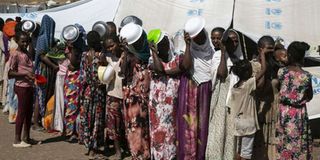States must join hands to resolve regional issues

Ethiopians who fled the conflict in the Tigray region waiting for food in Hamdayit camp after reaching Kassala State, Sudan on December 14, 2020.
What you need to know:
- The most recent conflict pitted the Ethiopia Federal government and Tigray People Liberation of Front (TPLF).
- Another live conflict is between Ethiopia and Egypt over the Grand Ethiopia Renaissance Dam.
For many years, the peace and security in the Horn of Africa has remained delicate due to lack of a binding collective action by the member states, who share the region’s prosperity.
The most recent conflict, with a huge potential of spawning a regional crisis, pitted the Ethiopia Federal government and Tigray People Liberation of Front (TPLF). Unfortunately, the region was exposed as one lacking a clear strategy and capacity to manage any conflict in the Horn.
Although the federal government announced some sort of military victory over the TPLF, the problem has not been resolved since it required more of a political than a military solution.
Having been in power for 27 years, Tigray community, with their small population of about six per cent in a nation boasting of a population of over 110 million, means that they have accumulated some stake in the country’s governance, which cannot be suppressed by a stroke of force.
The recent armed conflict between TPLF and the federal government was a manifestation of political grievances that have been boiling since Abiy Ahmed took power in Ethiopia in 2018 as the Prime Minister with his well intentions of drastically altering the system of governance, though without a serious reflection on its political ramification.
One of the critical institutions Tigray still dominates is the military — estimated at 250,000 — a huge number sufficient to pose a threat to a region that has seen many years of volatility among its neighbours.
There is already an ongoing dispute between Ethiopia and Sudan, which played host to Tigray refugees, who were displaced by the recent conflict — the crisis in Tigray provoked large scale displacement.
Peace and reconciliation
Another live conflict is between Ethiopia and Egypt over the Grand Ethiopia Renaissance Dam that is being built, despite huge protests from the latter, which has placed the two countries on the precipice of an open conflict.
In South Sudan, peace and reconciliation continue to call for greater efforts from national stakeholders and the region, to defend the gains made so far and ensure much needed peace, security and stability in the country.
In Somalia, despite progress in the fight against terrorism, transfer of security responsibility to the Somali security forces ahead of the African Union Mission in Somalia (Amisom)’s anticipated exit in 2021 and strengthening of the federal institutions, profound fragilities continue to pose challenges to the country.
As noted, the recent tensions between Somalia and Kenya, two neighbouring countries, which led to the breakdown of diplomatic relations, remain a serious concern. The two have a maritime dispute being arbitrated internationally.
There is need to look at the conflict resolution in the Horn of Africa as a collective responsibility among the regional states. Effective cooperation, with growth and stability, is good for the region and the continent.
The most important aspect of regional conflict mitigation mechanisms in the Horn of Africa should be pegged on managing conflicts and instability along borders, improved levels of trust and capacity building on conflict resolutions.
Mr Obonyo is a public policy analyst. [email protected]





